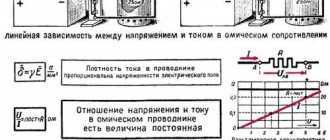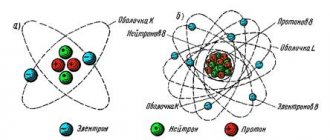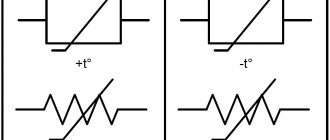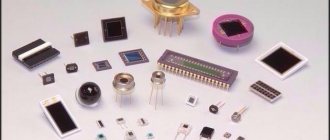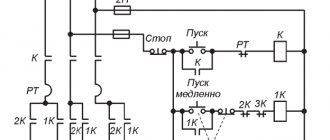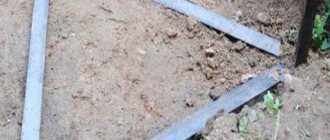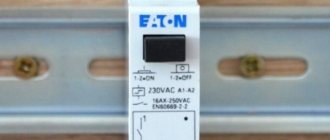I am publishing the first chapter of lectures on the theory of automatic control, after which your life will never be the same.
Lectures on the course “Management of Technical Systems” are given by Oleg Stepanovich Kozlov at the Department of “Nuclear Reactors and Power Plants”, Faculty of “Power Mechanical Engineering” of MSTU. N.E. Bauman. For which I am very grateful to him.
These lectures are just being prepared for publication in book form, and since there are TAU specialists, students, and those simply interested in the subject, any criticism is welcome.
1.1. Goals, principles of management, types of management systems, basic definitions, examples
The development and improvement of industrial production (energy, transport, mechanical engineering, space technology, etc.) requires a continuous increase in the productivity of machines and units, improving product quality, reducing costs and, especially in nuclear energy, a sharp increase in safety (nuclear, radiation, etc.) .d.) operation of nuclear power plants and nuclear installations.
The implementation of the set goals is impossible without the introduction of modern control systems, including both automated (with the participation of a human operator) and automatic (without the participation of a human operator) control systems (CS).
Definition:
Management is an organization of a particular technological process that ensures the achievement of a set goal.
Control theory
is a branch of modern science and technology. It is based (based) on both fundamental (general scientific) disciplines (for example, mathematics, physics, chemistry, etc.) and applied disciplines (electronics, microprocessor technology, programming, etc.).
Any control process (automatic) consists of the following main stages (elements):
- obtaining information about the control task;
- obtaining information about the result of management;
- analysis of received information;
- implementation of the decision (impact on the control object).
To implement the Management Process, the management system (CS) must have:
- sources of information about the management task;
- sources of information about control results (various sensors, measuring devices, detectors, etc.);
- devices for analyzing received information and developing solutions;
- actuators acting on the Control Object, containing: regulator, motors, amplification-converting devices, etc.
Definition:
If a control system (CS) contains all of the above parts, then it is closed.
Definition:
Control of a technical object using information about control results is called the feedback principle.
Schematically, such a control system can be represented as:
Rice.
1.1.1 — Structure of the control system (CS) If the control system (CS) has a block diagram, the form of which corresponds to Fig. 1.1.1, and functions (works) without human (operator) participation, then it is called an automatic control system (ACS).
If the control system operates with the participation of a person (operator), then it is called an automated control system.
If Control provides a given law of change of an object over time, regardless of the results of control, then such control is performed in an open loop, and the control itself is called program control.
Open-loop systems include industrial machines (conveyor lines, rotary lines, etc.), computer numerical control (CNC) machines: see example in Fig. 1.1.2.
Fig.1.1.2 - Example of program control
The master device can be, for example, a “copier”.
Since in this example there are no sensors (measurements) monitoring the part being manufactured, if, for example, the cutter was installed incorrectly or broke, then the set goal (production of the part) cannot be achieved (realized). Typically, in systems of this type, output control is required, which will only record the deviation of the dimensions and shape of the part from the desired one.
Automatic control systems are divided into 3 types:
- automatic control systems (ACS);
- automatic control systems (ACS);
- tracking systems (SS).
ACS and SS are subsets of ACS ==>.
Definition: An automatic control system that ensures the constancy of any physical quantity (group of quantities) in the control object is called an automatic control system (ACS).
Automatic control systems (ACS) are the most common type of automatic control systems.
The world's first automatic regulator (18th century) is the Watt regulator. This scheme (see Fig. 1.1.3) was implemented by Watt in England to maintain a constant speed of rotation of the wheel of a steam engine and, accordingly, to maintain a constant speed of rotation (motion) of the transmission pulley (belt).
In this circuit, the sensitive elements
(measuring sensors) are “weights” (spheres).
“Weights” (spheres) also “force” the rocker arm and then the valve to move. Therefore, this system can be classified as a direct control system, and the regulator can be classified as a direct-acting regulator, since it simultaneously performs the functions of both a “meter” and a “regulator”. In direct-acting regulators, additional source
of energy is required to move the regulator.
Rice.
1.1.3 — Diagram of a Watt automatic regulator In indirect control systems, the presence (presence) of an amplifier (for example, power), an additional actuator containing, for example, an electric motor, servomotor, hydraulic drive, etc. is required.
An example of an automatic control system (automatic control system), in the full sense of this definition, is a control system that ensures the launch of a rocket into orbit, where the controlled variable can be, for example, the angle between the rocket axis and the normal to the Earth ==> see Fig. 1.1.4.a and fig. 1.1.4.b
| Rice. 1.1.4(a) | Rice. 1.1.4 (b) |
Adaptive systems
If you are interested in how to control an adaptive type self-propelled gun, then first you should understand that there are three subclasses:
- extreme;
- self-tuning of parameters;
- self-tuning of the structure.
Extreme regulation is a stabilizing system that is monitored or has program control. In this case, a setting (law or program) is used, which can change under the influence of various factors and disturbances. As a result, the program allows the system to automatically reach the best operating mode.
The system itself is distinguished by the presence of a special automatic search device that can analyze some characteristics of the object. Based on this analysis, the required signal is sent, which allows one to obtain the desired value, which has an extreme value.
A system with self-tuning of its parameters can change a number of control parameters to increase the stability of the entire system. Naturally, to ensure such a result, a certain calculation program is used.
Self-tuning of the structure makes it possible to switch elements in the connection diagram. Or even introduce a number of new elements. As a result, the problem will be solved in the best possible way.
Functional classification
There are only 4 classes of control systems:
- Coordinating the work of mechanisms;
- Adjustment of technological process parameters;
- Automatic control;
- Automatic protection and blocking.
Conclusion
Such systems are used to automate a variety of production processes as much as possible. But in addition, they are also necessary for the operation of complex mechanisms. If you have any questions (for example, how the SAU M6 level indicator works or something similar), then contact specialists only. Only they will be able to explain in more detail how this or that system works, and which one is better to use in each specific case.
By the way, if you are going to order the installation of such systems, then the best option would be to choose GORINKOM LLC. Contact there and all your problems will be solved.
1.2. Structure of control systems: simple and multidimensional systems
In the theory of control of technical systems, it is often convenient to divide the system into a set of links connected into network structures. In the simplest case, the system contains one link, the input of which is supplied with an input action (input), and the response of the system (output) is obtained at the input.
In the theory of Technical Systems Management, 2 main ways of representing the links of control systems are used:
— in “input-output” variables;
— in state variables (for more details, see sections 6...7).
Representation in input-output variables is usually used to describe relatively simple systems that have one “input” (one control action) and one “output” (one controlled variable, see Figure 1.2.1).
Rice.
1.2.1 – Schematic representation of a simple control system Typically, such a description is used for technically simple ACS (automatic control systems).
Recently, representation in state variables has become widespread, especially for technically complex systems, including multidimensional automatic control systems. In Fig. 1.2.2 shows a schematic representation of a multidimensional automatic control system, where u1(t)…um(t)
— control actions (control vector),
y1(t)…yp(t)
— adjustable parameters of the ACS (output vector).
Rice.
1.2.2 — Schematic representation of a multidimensional control system Let us consider in more detail the structure of the ACS, presented in the “input-output” variables and having one input (input or master, or control action) and one output (output action or controlled (or adjustable) variable) .
Let us assume that the block diagram of such an ACS consists of a certain number of elements (links). By grouping the links according to the functional principle (what the links do), the structural diagram of the ACS can be reduced to the following typical form:
Rice.
1.2.3 — Block diagram of the automatic control system for the Symbol ε(t)
or the variable
ε(t)
denotes the mismatch (error) at the output of the comparing device, which can “operate” in the mode of both simple comparative arithmetic operations (most often subtraction, less often addition) and more complex comparative operations (procedures).
Since y1(t) = y(t)*k1
, where
k1
is the gain, then ==>
ε(t) = x(t) - y1(t) = x(t) - k1*y(t)
The task of the control system is (if it is stable) to “work” to eliminate the mismatch (error) ε(t)
, i.e.
==> ε(t) → 0
.
It should be noted that the control system is affected by both external influences (controlling, disturbing, interference) and internal interference. Interference differs from impact by the stochasticity (randomness) of its existence, while impact is almost always deterministic.
To denote the control (setting action) we will use either x(t)
, or
u(t)
.
Classification
In industrial production, the following classes of automatic and automated control systems are distinguished.
- Decentralized. Necessary in structures where independent objects are automated.
- Centralized. Suitable for single control. Among its advantages are the interaction of information, the likelihood of changing input data, and greater operational efficiency. Disadvantages include the high need for security and productivity, the large length of communication channels when objects are dispersed.
- Central dispersed. It retains the ability to centralize control. Its advantages are a reduction in inspection and management requirements without compromising quality. Disadvantages of the control system: complex information processes, redundancy of equipment and complexity of synchronization.
- Hierarchical structure. It is used for holdings where automatic and automated control systems cannot operate at the same level. As the amount of information increases, a hierarchy of tasks is created.
Automatic and automated control systems are subject to a single standard. Any authorized employee can work with the database. With the help of automatic and automated control systems, the level of personnel work and other indicators are monitored.
1.3. Basic laws of control
If we return to the last figure (block diagram of the ACS in Fig. 1.2.3), then it is necessary to “decipher” the role played by the amplification-converting device (what functions it performs).
If an amplification-converting device (ACD) only amplify (or attenuate) the mismatch signal ε(t), namely: , where is the proportionality coefficient (in the particular case = Const), then such a control mode of a closed-loop ACS is called a proportional control mode (P -control).
If the control unit generates an output signal ε1(t), proportional to the error ε(t) and the integral of ε(t), i.e. , then this control mode is called proportional-integrating (PI control). ==> , where b
– proportionality coefficient (in the particular case
b = Const
).
Typically, PI control is used to improve control (regulation) accuracy.
If the control unit generates an output signal ε1(t), proportional to the error ε(t) and its derivative, then this mode is called proportional-differentiating (PD control): ==>
Typically, the use of PD control increases the performance of the ACS
If the control unit generates an output signal ε1(t), proportional to the error ε(t), its derivative, and the integral of the error ==>, then this control mode is called proportional-integral-differentiating control mode (PID control).
PID control often allows you to provide “good” control accuracy with “good” speed
Historical reference
One of the main functions of A. at. is production automation, which increases labor productivity and allows, while maintaining the required quality, to increase the volume of production of commercial products. The task of operational management of technological processes and objects in real time arose simultaneously with the advent of commodity production. Initially, this problem was solved by a person who approximately assessed the progress of the technological and production process, adjusted the parameters if necessary, started and completed the process. As production became more complex, special control and measuring devices began to be used, which made it possible to obtain reliable data and objectively evaluate the progress of the technological process. In many industries, with an increase in the quantity and quality of products, special requirements related to labor intensity and the qualifications of workers have increased. Further growth in capacity and other equipment parameters led to the need to free the worker (who became the “weak link” in the production process) from the tedious task of being near working machines and devices, monitoring instrument readings and manually performing the necessary switching and parameter adjustments. An important technical achievement was the creation of measuring, regulating and actuating devices with external energy sources, mechanisms with pneumatic, hydraulic and electric drives. This made it possible to organize remote control posts and the simplest automatic control systems in the technological process. With the advent of instrumentation and control devices with a unified interface (standardized input and output signals), it became possible to combine local posts into central control panels. Mnemonic diagrams began to be used, in which indicating and signaling devices were built into graphic images of technological processes, which facilitated the operator’s work.
1.4. Classification of automatic control systems
1.4.1. Classification by type of mathematical description
Based on the type of mathematical description (equations of dynamics and statics), automatic control systems (ACS) are divided into linear and nonlinear systems (ACS or ACS).
Each “subclass” (linear and nonlinear) is divided into a number of “subclasses”. For example, linear self-propelled guns (SAP) have differences in the type of mathematical description. Since this semester will consider the dynamic properties of only linear automatic control (regulation) systems, below we provide a classification according to the type of mathematical description for linear automatic control systems (ACS):
1) Linear automatic control systems described in input-output variables by ordinary differential equations (ODE) with constant coefficients:
where
x(t)
– input influence;
y(t)
– output action (controlled variable).
If we use the operator (“compact”) form of writing a linear ODE, then equation (1.4.1) can be represented in the following form:
where
p = d/dt
is the differentiation operator;
L(p), N(p)
are the corresponding linear differential operators, which are equal to:
2) Linear automatic control systems described by linear ordinary differential equations (ODE) with variable (in time) coefficients:
In the general case, such systems can be classified as nonlinear automatic control systems (NSA).
3) Linear automatic control systems described by linear difference equations:
where
f(...)
is a linear function of arguments;
k = 1, 2, 3…
are integers;
Δt
– quantization interval (sampling interval).
Equation (1.4.4) can be represented in a “compact” notation:
Typically, this description of linear automatic control systems (ACS) is used in digital control systems (using a computer).
4) Linear automatic control systems with delay:
where
L(p), N(p)
are linear differential operators;
τ
is the delay time or delay constant.
If the operators L(p)
and
N(p)
degenerate (
L(p) = 1; N(p) = 1
), then equation (1.4.6) corresponds to the mathematical description of the dynamics of the ideal delay link:
and a graphical illustration of its properties is shown in Fig. 1.4.1
Rice. 1.4.1 — Graphs of input and output of the ideal delay link
5) Linear automatic control systems described by linear partial
. Such automatic control systems are often called distributed control systems. ==> An “abstract” example of such a description:
System of equations (1.4.7) describes the dynamics of a linearly distributed automatic control system, i.e. the controlled quantity depends not only on time, but also on one spatial coordinate. If the control system is a “spatial” object, then ==>
where depends on time and spatial coordinates determined by the radius vector
6) ACS described by systems of ODEs, or systems of difference equations, or systems of partial differential equations ==> and so on...
A similar classification can be proposed for nonlinear automatic control systems (SAP)…
For linear systems the following requirements are met:
- linearity of the static characteristics of the ACS;
- linearity of the dynamics equation, i.e. variables enter the dynamics equation only in linear combination.
The static characteristic is the dependence of the output on the magnitude of the input influence in steady state (when all transient processes have died out).
For systems described by linear ordinary differential equations with constant coefficients, the static characteristic is obtained from the dynamic equation (1.4.1) by setting all non-stationary terms to zero ==>
Figure 1.4.2 shows examples of linear and nonlinear static characteristics of automatic control (regulation) systems.
Rice.
1.4.2 - Examples of static linear and nonlinear characteristics Nonlinearity of terms containing time derivatives in dynamic equations can arise when using nonlinear mathematical operations (*, /, , , sin, ln, etc.). For example, considering the dynamics equation of some “abstract” self-propelled gun
note that in this equation, with a linear static characteristic, the second and third terms (dynamic terms) on the left side of the equation are nonlinear, therefore the ACS described by a similar equation is nonlinear in the dynamic
plan.
1.4.2. Classification according to the nature of the transmitted signals
Based on the nature of the transmitted signals, automatic control (or regulation) systems are divided into:
- continuous systems (continuous systems);
- relay systems (relay action systems);
- discrete action systems (pulse and digital).
A continuous system is such an automatic control system, in each of the links of which a continuous change in the input signal over time corresponds to a continuous change in the output signal, and the law of change in the output signal can be arbitrary. For the ACS to be continuous, it is necessary that the static characteristics of all links be continuous.
Rice.
1.4.3 — Example of a continuous system A relay operating system is an automatic control system in which at least in one link, with a continuous change in the input value, the output value at some moments of the control process changes “jump” depending on the value of the input signal. The static characteristic of such a link has points of break or break with a break.
Rice.
1.4.4 — Examples of relay static characteristics A discrete action system is a system in which at least in one link, with a continuous change in the input value, the output value has the form of individual pulses appearing after a certain period of time.
The link that converts a continuous signal into a discrete signal is called a pulse link. A similar type of transmitted signals occurs in an automatic control system with a computer or controller.
The most commonly implemented methods (algorithms) for converting a continuous input signal into a pulsed output signal are:
- pulse amplitude modulation (PAM);
- Pulse width modulation (PWM).
In Fig. Figure 1.4.5 presents a graphical illustration of the pulse amplitude modulation (PAM) algorithm. At the top of Fig. the time dependence x(t)
— signal at the input to the pulse link.
The output signal of the pulse block (link) y(t)
is a sequence of rectangular pulses appearing with a constant quantization period Δt (see the bottom of the figure). The duration of the pulses is the same and equal to Δ. The pulse amplitude at the output of the block is proportional to the corresponding value of the continuous signal x(t) at the input of this block.
1.4.5 — Implementation of pulse amplitude modulation This method of pulse modulation was very common in the electronic measuring equipment of control and protection systems (CPS) of nuclear power plants (NPP) in the 70s...80s of the last century.
In Fig. Figure 1.4.6 shows a graphical illustration of the pulse width modulation (PWM) algorithm. At the top of Fig. 1.14 shows the time dependence x(t)
– signal at the input to the pulse link.
The output signal of the pulse block (link) y(t)
is a sequence of rectangular pulses appearing with a constant quantization period
Δt
(see the bottom of Fig. 1.14).
The amplitude of all pulses is the same. The pulse duration Δt
at the output of the block is proportional to the corresponding value of the continuous signal
x(t)
at the input of the pulse block.
1.4.6 — Implementation of pulse-width modulation This method of pulse modulation is currently the most common in electronic measuring equipment of control and protection systems (CPS) of nuclear power plants (NPP) and ACS of other technical systems.
Concluding this subsection, it should be noted that if the characteristic time constants in other parts of the automatic control system (SAR) are significantly greater than Δt (by orders of magnitude), then the pulse system can be considered a continuous automatic control system (when using both AIM and PWM).

